An official website of the United States government
 United States Department of Labor
United States Department of Labor
Conduct research in breeding, physiology, production, yield, and management of crops and agricultural plants or trees, shrubs, and nursery stock, their growth in soils, and control of pests; or study the chemical, physical, biological, and mineralogical composition of soils as they relate to plant or crop growth. May classify and map soils and investigate effects of alternative practices on soil and crop productivity.
Employment estimate and mean wage estimates for Soil and Plant Scientists:
| Employment (1) | Employment RSE (3) |
Mean hourly wage |
Mean annual wage (2) |
Wage RSE (3) |
|---|---|---|---|---|
| 15,610 | 4.8 % | $ 36.68 | $ 76,290 | 2.0 % |
Percentile wage estimates for Soil and Plant Scientists:
| Percentile | 10% | 25% | 50% (Median) |
75% | 90% |
|---|---|---|---|---|---|
| Hourly Wage | $ 19.22 | $ 24.15 | $ 32.09 | $ 45.08 | $ 61.03 |
| Annual Wage (2) | $ 39,980 | $ 50,230 | $ 66,750 | $ 93,770 | $ 126,950 |
Industries with the highest published employment and wages for Soil and Plant Scientists are provided. For a list of all industries with employment in Soil and Plant Scientists, see the Create Customized Tables function.
Industries with the highest levels of employment in Soil and Plant Scientists:
| Industry | Employment (1) | Percent of industry employment | Hourly mean wage | Annual mean wage (2) |
|---|---|---|---|---|
| Scientific Research and Development Services | 2,970 | 0.37 | $ 46.38 | $ 96,480 |
| Management, Scientific, and Technical Consulting Services | 2,490 | 0.16 | $ 33.68 | $ 70,050 |
| Colleges, Universities, and Professional Schools | 2,240 | 0.08 | $ 28.81 | $ 59,920 |
| Merchant Wholesalers, Nondurable Goods (4241, 4247, and 4249 only) | 1,280 | 0.24 | $ 37.48 | $ 77,950 |
| Federal Executive Branch (OEWS Designation) | 1,170 | 0.06 | $ 43.07 | $ 89,590 |
Industries with the highest concentration of employment in Soil and Plant Scientists:
| Industry | Employment (1) | Percent of industry employment | Hourly mean wage | Annual mean wage (2) |
|---|---|---|---|---|
| Museums, Historical Sites, and Similar Institutions | 770 | 0.58 | $ 26.79 | $ 55,720 |
| Farm Product Raw Material Merchant Wholesalers | 350 | 0.52 | $ 31.67 | $ 65,870 |
| Scientific Research and Development Services | 2,970 | 0.37 | $ 46.38 | $ 96,480 |
| Merchant Wholesalers, Nondurable Goods (4241, 4247, and 4249 only) | 1,280 | 0.24 | $ 37.48 | $ 77,950 |
| Management, Scientific, and Technical Consulting Services | 2,490 | 0.16 | $ 33.68 | $ 70,050 |
Top paying industries for Soil and Plant Scientists:
| Industry | Employment (1) | Percent of industry employment | Hourly mean wage | Annual mean wage (2) |
|---|---|---|---|---|
| Merchant Wholesalers, Nondurable Goods (4244 and 4248 only) | 50 | (7) | $ 54.47 | $ 113,290 |
| Electric Power Generation, Transmission and Distribution | 60 | 0.02 | $ 48.37 | $ 100,600 |
| Chemical Manufacturing (3251, 3252, 3253, and 3259 only) | 60 | 0.02 | $ 46.74 | $ 97,220 |
| Services to Buildings and Dwellings | 180 | 0.01 | $ 46.45 | $ 96,620 |
| Scientific Research and Development Services | 2,970 | 0.37 | $ 46.38 | $ 96,480 |
States and areas with the highest published employment, location quotients, and wages for Soil and Plant Scientists are provided. For a list of all areas with employment in Soil and Plant Scientists, see the Create Customized Tables function.
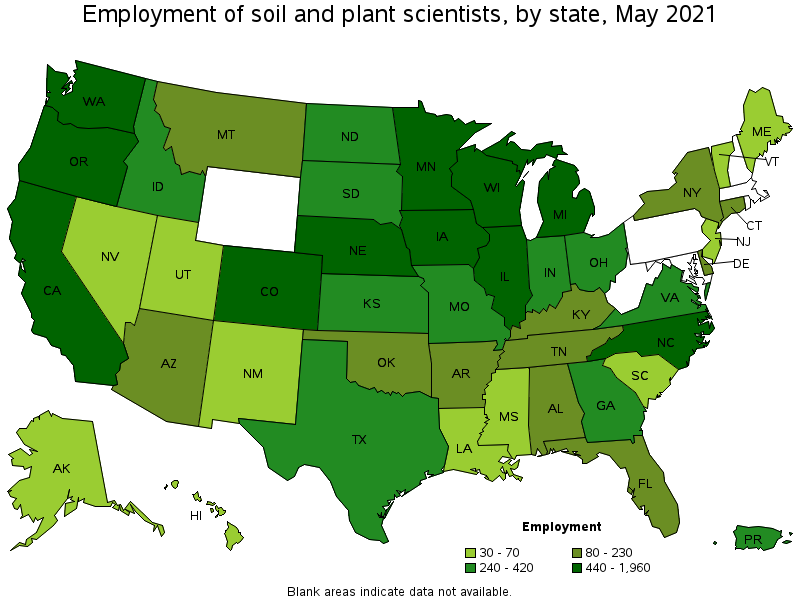
States with the highest employment level in Soil and Plant Scientists:
| State | Employment (1) | Employment per thousand jobs | Location quotient (9) | Hourly mean wage | Annual mean wage (2) |
|---|---|---|---|---|---|
| North Carolina | 1,960 | 0.44 | 3.99 | $ 49.40 | $ 102,740 |
| California | 1,340 | 0.08 | 0.73 | $ 42.61 | $ 88,630 |
| Iowa | 980 | 0.66 | 5.96 | $ 35.63 | $ 74,110 |
| Illinois | 960 | 0.17 | 1.53 | $ 28.91 | $ 60,130 |
| Washington | 930 | 0.29 | 2.62 | $ 32.63 | $ 67,860 |
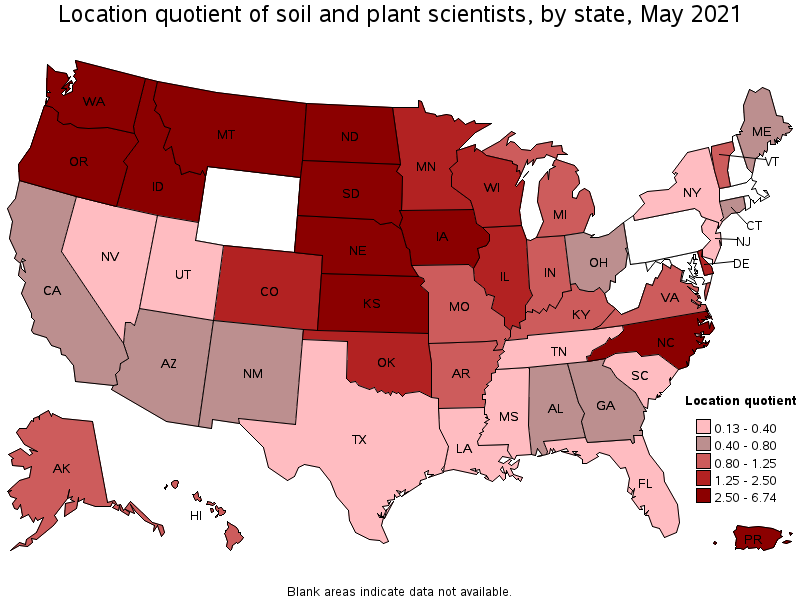
States with the highest concentration of jobs and location quotients in Soil and Plant Scientists:
| State | Employment (1) | Employment per thousand jobs | Location quotient (9) | Hourly mean wage | Annual mean wage (2) |
|---|---|---|---|---|---|
| South Dakota | 310 | 0.75 | 6.74 | $ 31.66 | $ 65,860 |
| Nebraska | 680 | 0.70 | 6.36 | $ 31.61 | $ 65,750 |
| North Dakota | 260 | 0.66 | 6.00 | $ 31.08 | $ 64,650 |
| Iowa | 980 | 0.66 | 5.96 | $ 35.63 | $ 74,110 |
| Idaho | 340 | 0.46 | 4.11 | $ 39.41 | $ 81,970 |
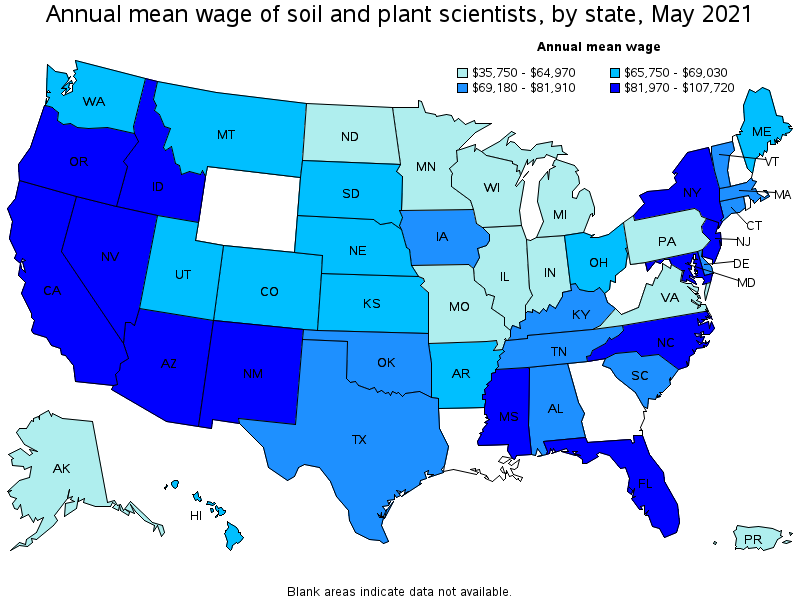
Top paying states for Soil and Plant Scientists:
| State | Employment (1) | Employment per thousand jobs | Location quotient (9) | Hourly mean wage | Annual mean wage (2) |
|---|---|---|---|---|---|
| Nevada | 30 | 0.03 | 0.24 | $ 51.79 | $ 107,720 |
| North Carolina | 1,960 | 0.44 | 3.99 | $ 49.40 | $ 102,740 |
| Mississippi | 40 | 0.04 | 0.35 | $ 46.10 | $ 95,890 |
| Maryland | (8) | (8) | (8) | $ 45.02 | $ 93,640 |
| California | 1,340 | 0.08 | 0.73 | $ 42.61 | $ 88,630 |
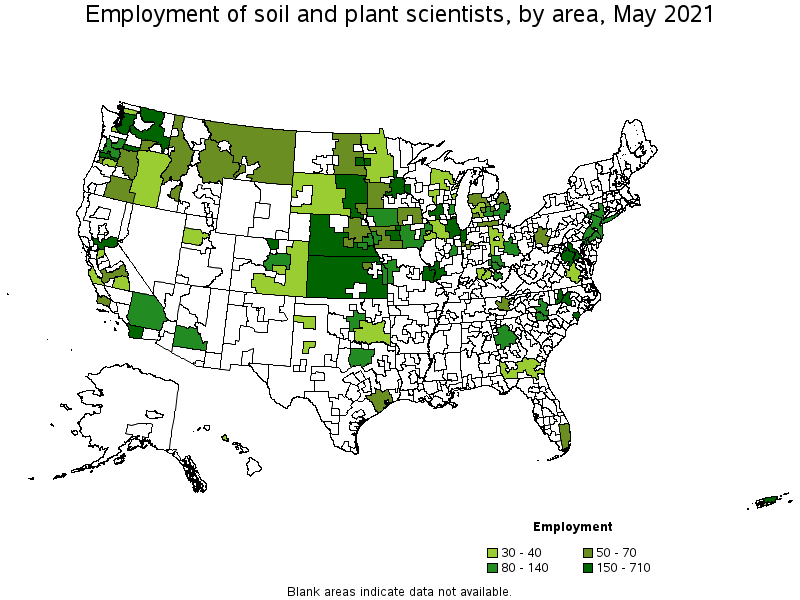
Metropolitan areas with the highest employment level in Soil and Plant Scientists:
| Metropolitan area | Employment (1) | Employment per thousand jobs | Location quotient (9) | Hourly mean wage | Annual mean wage (2) |
|---|---|---|---|---|---|
| Raleigh, NC | 710 | 1.12 | 10.07 | $ 52.56 | $ 109,320 |
| Chicago-Naperville-Elgin, IL-IN-WI | 690 | 0.16 | 1.48 | $ 27.82 | $ 57,860 |
| Durham-Chapel Hill, NC | 560 | 1.80 | 16.28 | $ 53.58 | $ 111,450 |
| Seattle-Tacoma-Bellevue, WA | 470 | 0.25 | 2.21 | $ 32.82 | $ 68,260 |
| Washington-Arlington-Alexandria, DC-VA-MD-WV | 430 | 0.15 | 1.32 | $ 38.26 | $ 79,580 |
| Des Moines-West Des Moines, IA | 310 | 0.87 | 7.88 | $ 42.31 | $ 88,000 |
| Wilmington, NC | 300 | 2.34 | 21.11 | $ 51.09 | $ 106,260 |
| Minneapolis-St. Paul-Bloomington, MN-WI | 270 | 0.15 | 1.34 | $ 32.45 | $ 67,500 |
| Madison, WI | 240 | 0.64 | 5.81 | $ 31.92 | $ 66,390 |
| Ames, IA | 180 | 4.02 | 36.28 | $ 29.60 | $ 61,570 |
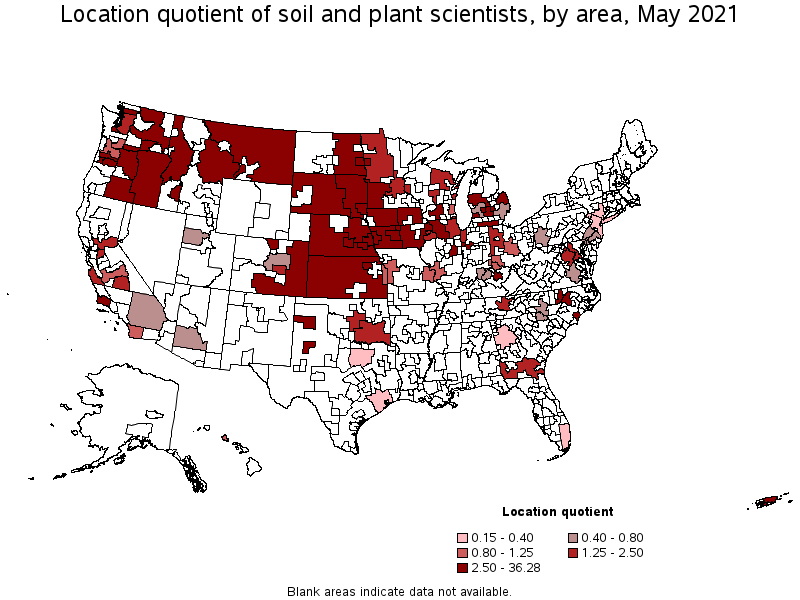
Metropolitan areas with the highest concentration of jobs and location quotients in Soil and Plant Scientists:
| Metropolitan area | Employment (1) | Employment per thousand jobs | Location quotient (9) | Hourly mean wage | Annual mean wage (2) |
|---|---|---|---|---|---|
| Ames, IA | 180 | 4.02 | 36.28 | $ 29.60 | $ 61,570 |
| Wilmington, NC | 300 | 2.34 | 21.11 | $ 51.09 | $ 106,260 |
| Durham-Chapel Hill, NC | 560 | 1.80 | 16.28 | $ 53.58 | $ 111,450 |
| Corvallis, OR | 60 | 1.66 | 15.00 | $ 43.28 | $ 90,020 |
| Manhattan, KS | 50 | 1.27 | 11.49 | $ 26.58 | $ 55,290 |
| Grand Island, NE | 50 | 1.21 | 10.88 | $ 39.78 | $ 82,750 |
| Raleigh, NC | 710 | 1.12 | 10.07 | $ 52.56 | $ 109,320 |
| Fargo, ND-MN | 150 | 1.08 | 9.73 | $ 29.63 | $ 61,630 |
| Fort Collins, CO | 160 | 1.02 | 9.25 | $ 31.46 | $ 65,430 |
| Champaign-Urbana, IL | 90 | 0.95 | 8.55 | $ 32.09 | $ 66,740 |
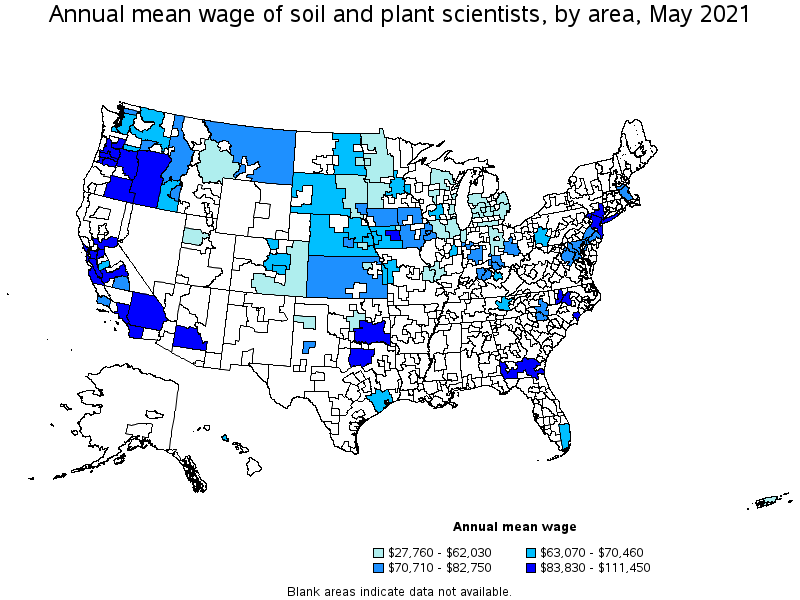
Top paying metropolitan areas for Soil and Plant Scientists:
| Metropolitan area | Employment (1) | Employment per thousand jobs | Location quotient (9) | Hourly mean wage | Annual mean wage (2) |
|---|---|---|---|---|---|
| Durham-Chapel Hill, NC | 560 | 1.80 | 16.28 | $ 53.58 | $ 111,450 |
| Dallas-Fort Worth-Arlington, TX | 100 | 0.03 | 0.24 | $ 52.64 | $ 109,490 |
| Raleigh, NC | 710 | 1.12 | 10.07 | $ 52.56 | $ 109,320 |
| Wilmington, NC | 300 | 2.34 | 21.11 | $ 51.09 | $ 106,260 |
| Salinas, CA | 40 | 0.22 | 2.01 | $ 50.68 | $ 105,420 |
| Fresno, CA | 50 | 0.12 | 1.09 | $ 48.98 | $ 101,880 |
| San Francisco-Oakland-Hayward, CA | (8) | (8) | (8) | $ 47.12 | $ 98,010 |
| Los Angeles-Long Beach-Anaheim, CA | (8) | (8) | (8) | $ 45.79 | $ 95,250 |
| San Diego-Carlsbad, CA | 160 | 0.11 | 1.01 | $ 45.56 | $ 94,770 |
| San Jose-Sunnyvale-Santa Clara, CA | (8) | (8) | (8) | $ 43.70 | $ 90,890 |
Nonmetropolitan areas with the highest employment in Soil and Plant Scientists:
| Nonmetropolitan area | Employment (1) | Employment per thousand jobs | Location quotient (9) | Hourly mean wage | Annual mean wage (2) |
|---|---|---|---|---|---|
| East South Dakota nonmetropolitan area | 200 | 1.60 | 14.46 | $ 29.81 | $ 62,000 |
| South Nebraska nonmetropolitan area | 200 | 1.35 | 12.19 | $ 32.09 | $ 66,740 |
| Kansas nonmetropolitan area | 190 | 0.50 | 4.48 | $ 34.53 | $ 71,820 |
| Eastern Washington nonmetropolitan area | 160 | 1.74 | 15.66 | $ 31.16 | $ 64,800 |
| Northwest Iowa nonmetropolitan area | 140 | 1.09 | 9.80 | $ 34.43 | $ 71,620 |
Nonmetropolitan areas with the highest concentration of jobs and location quotients in Soil and Plant Scientists:
| Nonmetropolitan area | Employment (1) | Employment per thousand jobs | Location quotient (9) | Hourly mean wage | Annual mean wage (2) |
|---|---|---|---|---|---|
| Eastern Washington nonmetropolitan area | 160 | 1.74 | 15.66 | $ 31.16 | $ 64,800 |
| East South Dakota nonmetropolitan area | 200 | 1.60 | 14.46 | $ 29.81 | $ 62,000 |
| South Nebraska nonmetropolitan area | 200 | 1.35 | 12.19 | $ 32.09 | $ 66,740 |
| East North Dakota nonmetropolitan area | 70 | 1.20 | 10.83 | $ 31.78 | $ 66,110 |
| Northwest Iowa nonmetropolitan area | 140 | 1.09 | 9.80 | $ 34.43 | $ 71,620 |
Top paying nonmetropolitan areas for Soil and Plant Scientists:
| Nonmetropolitan area | Employment (1) | Employment per thousand jobs | Location quotient (9) | Hourly mean wage | Annual mean wage (2) |
|---|---|---|---|---|---|
| South Georgia nonmetropolitan area | 40 | 0.19 | 1.74 | $ 48.18 | $ 100,210 |
| Southeast Oklahoma nonmetropolitan area | 40 | 0.25 | 2.28 | $ 46.05 | $ 95,790 |
| Eastern Oregon nonmetropolitan area | 40 | 0.53 | 4.79 | $ 41.46 | $ 86,230 |
| Central Oregon nonmetropolitan area | 50 | 0.76 | 6.83 | $ 40.51 | $ 84,260 |
| East-Central Montana nonmetropolitan area | 60 | 1.00 | 8.99 | $ 35.13 | $ 73,060 |
These estimates are calculated with data collected from employers in all industry sectors, all metropolitan and nonmetropolitan areas, and all states and the District of Columbia. The top employment and wage figures are provided above. The complete list is available in the downloadable XLS files.
The percentile wage estimate is the value of a wage below which a certain percent of workers fall. The median wage is the 50th percentile wage estimate—50 percent of workers earn less than the median and 50 percent of workers earn more than the median. More about percentile wages.
(1) Estimates for detailed occupations do not sum to the totals because the totals include occupations not shown separately. Estimates do not include self-employed workers.
(2) Annual wages have been calculated by multiplying the hourly mean wage by a "year-round, full-time" hours figure of 2,080 hours; for those occupations where there is not an hourly wage published, the annual wage has been directly calculated from the reported survey data.
(3) The relative standard error (RSE) is a measure of the reliability of a survey statistic. The smaller the relative standard error, the more precise the estimate.
(7) The value is less than .005 percent of industry employment.
(8) Estimate not released.
(9) The location quotient is the ratio of the area concentration of occupational employment to the national average concentration. A location quotient greater than one indicates the occupation has a higher share of employment than average, and a location quotient less than one indicates the occupation is less prevalent in the area than average.
Other OEWS estimates and related information:
May 2021 National Occupational Employment and Wage Estimates
May 2021 State Occupational Employment and Wage Estimates
May 2021 Metropolitan and Nonmetropolitan Area Occupational Employment and Wage Estimates
May 2021 National Industry-Specific Occupational Employment and Wage Estimates
Last Modified Date: March 31, 2022